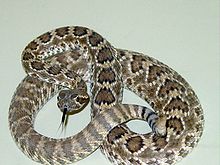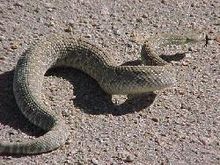- Crotalus scutulatus
-
Crotalus scutulatus Conservation status Scientific classification Kingdom: Animalia Phylum: Chordata Subphylum: Vertebrata Class: Reptilia Order: Squamata Suborder: Serpentes Family: Viperidae Subfamily: Crotalinae Genus: Crotalus Species: C. scutulatus Binomial name Crotalus scutulatus
(Kennicott, 1861)Synonyms Crotalus scutulatus is a venomous pitviper species found in the deserts of the southwestern United States and central Mexico. It is perhaps best known for its potent neurotoxic venom. Two subspecies are recognized, including the nominate subspecies described here.[5]
Contents
Description
This species grows to an average of less than 100 centimetres (3.3 ft) in length, with a maximum of 137.3 centimetres (4.50 ft).[4]
The color varies from shades of brown to pale green depending on the surroundings. The green hue found among Mojave rattlesnakes has led to them being known as "Mojave greens" in some areas. Like C. atrox (the Western Diamondback rattlesnake), which it closely resembles, the C. scutulatus has a dark diamond pattern along its back. With C. scutulatus the white bands on the tail tend to be wider than the black, while the band width is usually more equal in C. atrox. Additionally, C. scutulatus has enlarged scales on top of the head between the supraoculars and the light post-ocular stripe passes behind the corner of the mouth. In C. atrox, the crown is covered in small scales and the light post-ocular stripe intersects the mouth.[3][6]
Common names
Mojave rattlesnake,[2][3][7] Mojave green,[3] Mohave rattlesnake,[4] Mojave diamond rattlesnake, Mojave rattler, scutulated rattlesnake.[7] In Mexico, this species is known as Chiauhcóatl (Nahuatl), or víbora de cascabel (rattlesnake in Spanish).[4] C. s. scutulatus has also been referred to as the northern Mojave rattlesnake.[5]
Campbell and Lamar (2004) [4] support the English name "Mohave rattlesnake", but do so with some reluctance because so little of the snake's range lies within the Mojave Desert. They don't support the spelling "Mojave", because the name "Mohave" derives from the Native American term hamakhava.[4]
Geographic range
Found in the southwestern United States in southern California, southern Nevada, extreme southwestern Utah, most of Arizona, southern New Mexico and western Texas. Also ranges southward through much of Mexico to southern Puebla. It is found in deserts and other areas with xeric vegetation from near sea level to about 2500 m altitude. No type locality is given. Smith and Taylor (1950) proposed "Wickenburg, Maricopa county, Arizona" (USA), while Schmidt (1953) listed the type locality as "Mojave Desert, California" (USA).[1] See map at right.
Habitat
Primarily a snake of high desert or lower mountain slopes, they are often found near scrub brush such as mesquite and creosote, but may also reside in lowland areas of sparse vegetation, among cacti, Joshua tree forests, or grassy plains. They tend to avoid densely vegetated and rocky areas, preferring open arid habitats.[4]
Conservation status
This species is classified as Least Concern (LC) on the IUCN Red List of Threatened Species (v3.1, 2001).[8] Species are listed as such due to their wide distribution, presumed large population, or because it is unlikely to be declining fast enough to qualify for listing in a more threatened category. The population trend is stable. Year assessed: 2007.[9]
Behavior
Most active from April to September, and Brumate alone or in small groups during the winter. Ambush predators, they eat mostly small rodents and lizards. Females bear live young, from two to seventeen (average about eight), from July through September.[3][10] Although they have a reputation for being aggressive towards people, such behavior is not described in the scientific literature. Like other rattlesnakes they will defend themselves vigorously when disturbed.[citation needed]
Venom
Rattlesnake venoms are complex cocktails of enzymes and other proteins that vary greatly in composition and effects, not only between species, but also between geographic populations within the same species. C. scutulatus is widely regarded as producing one of the most toxic snake venoms in the New World, based on LD50 studies in laboratory mice.[11] Their potent venom is the result of a presynaptic neurotoxin composed of two distinct peptide subunits.[12] The basic subunit (a phospholipase A2) is mildly toxic and apparently rather common in North American rattlesnake venoms.[13] The less common acidic subunit is not toxic by itself but, in combination with the basic subunit, produces the potent neurotoxin called “Mojave toxin.” Nearly identical neurotoxins have been discovered in five North American rattlesnake species besides C. scutulatus.[13] However, not all populations express both subunits. The venom of many Mojave rattlesnakes from south-central Arizona lacks the acidic subunit and has been designated “Venom B,” while Mojave rattlesnakes tested from all other areas express both subunits and have been designated “Venom A” populations.[14] Based on median LD50 values in lab mice, Venom A bite from Mojave rattlesnakes is more than ten times as toxic as Venom B, which lacks Mojave toxin.[15]
Bite symptoms
Venom B causes pronounced proteolytic and hemorrhagic effects, similar to the bites of other rattlesnake species; these effects are significantly reduced or absent from bites by Venom A snakes.[16]
In people bitten by Venom A Mojave rattlesnakes (those outside the relatively small Venom B area in south-central Arizona), the onset of serious signs and symptoms can be delayed, sometimes leading to an initial underestimation of the severity of the bite. Significant envenomations (as with all snakebites, the quantity of venom injected is highly variable and unpredictable) can produce vision abnormalities and difficulty swallowing and speaking. In severe cases, skeletal muscle weakness can lead to difficulty breathing and even respiratory failure.[16] Contrary to popular belief, fatalities are uncommon.[17][18]
Antivenom
Unlike the rattlesnake antivenom used in the United States over the previous fifty years, CroFab antivenom (approved by the U.S. Food and Drug Administration (FDA) in October 2001) uses Mojave rattlesnake Venom A (in addition to venom from three other species) in its manufacture,[19] making it particularly effective for treatment of Venom A Mojave rattlesnake bites. Antibodies in CroFab produced by the other three species' venoms effectively neutralize Mojave rattlesnake Venom B.
Subspecies
Subspecies[5] Taxon author[5] Common name[10] Geographic range[4] C. s. salvini Günther, 1895 Huamantlan rattlesnake Mexico, from Hidalgo through Tlaxcala and Puebla to southwestern Veracruz. C. s. scutulatus (Kennicott, 1861) Mojave rattlesnake The United States from California eastward to west Texas and southward to Querétaro in Mexico. See also
- List of crotaline species and subspecies
- Crotalus by common name
- Crotalus by taxonomic synonyms
- Crotalinae by common name
- Crotalinae by taxonomic synonyms
References
- ^ a b McDiarmid RW, Campbell JA, Touré T. 1999. Snake Species of the World: A Taxonomic and Geographic Reference, vol. 1. Herpetologists' League. 511 pp. ISBN 1-893777-00-6 (series). ISBN 1-893777-01-4 (volume).
- ^ a b Crothier, B.I. et al. 2003. Scientific and standard English names of amphibians and reptiles of North America north of Mexico: Update. Herpetological Review 34:196-203
- ^ a b c d e f Stebbins, R.C. 2003. A Field Guide to Western Reptiles and Amphibians. Boston: Houghton Mifflin & Co.
- ^ a b c d e f g h Campbell JA, Lamar WW. 2004. The Venomous Reptiles of the Western Hemisphere. Comstock Publishing Associates, Ithaca and London. 870 pp. 1500 plates. ISBN 0-8014-4141-2.
- ^ a b c d "Crotalus scutulatus". Integrated Taxonomic Information System. http://www.itis.gov/servlet/SingleRpt/SingleRpt?search_topic=TSN&search_value=174317. Retrieved 5 January 2007.
- ^ Bush, S.P., M.D. Cardwell. 1999. Mojave rattlesnake (Crotalus scutulatus scutulatus) identification. Wilderness and Environmental Medicine 10:6-9.
- ^ a b Wright AH, Wright AA. 1957. Handbook of Snakes. Comstock Publishing Associates. (7th printing, 1985). 1105 pp. ISBN 0-8014-0463-0.
- ^ Crotalus scutulatus at the IUCN Red List. Accessed 13 September 2007.
- ^ 2001 Categories & Criteria (version 3.1) at the IUCN Red List. Accessed 13 September 2007.
- ^ a b Klauber LM. 1997. Rattlesnakes: Their Habitats, Life Histories, and Influence on Mankind. Second Edition. First published in 1956, 1972. University of California Press, Berkeley. ISBN 0-520-21056-5.
- ^ Glenn, J.L., R.C.Straight. 1982. The rattlesnakes and their venom yield and lethal toxicity. In: Tu, A. (ed) Rattlesnake Venoms, Their Actions and Treatment. New York: Marcel Dekker, Inc.
- ^ Aird, S.D., et al. 1985. Rattlesnake presynaptic neurotoxins: primary structures and evolutionary origin of the acidic subunit. Biochemistry 24:7054-58.
- ^ a b Powell, R.L. 2003. Evolutionary Genetics of Mojave Toxin Among Selected Rattlesnake Species (Squamata: Crotalinae). Unpublished PhD dissertation. El Paso: University of Texas.
- ^ Glenn, J.L., R.C. Straight. 1978. Mojave rattlesnake Crotalus scutulatus scutulatus venom: Variation in toxicity with geographical origin. Toxicon 16:81-84.
- ^ Hendon, R.A., A.L. Bieber. 1982. Presynaptic toxins from rattlesnake venoms. In: Tu, A. (ed) Rattlesnake Venoms, Their Actions and Treatment. New York: Marcel Dekker, Inc.
- ^ a b Norris RA. 2004. Venom poisoning by North American reptiles. In Campbell JA, Lamar WW. 2004. The Venomous Reptiles of the Western Hemisphere. Comstock Publishing Associates, Ithaca and London. 870 pp. 1500 plates. ISBN 0-8014-4141-2.
- ^ Watt, C.H. 1985. Treatment of poisonous snakebite with emphasis on digit dertotomy. Southern Medical Journal 78:694-699.
- ^ Gold, B.S., W.A. Wingert. 1994. Snake venom poisoning in the United States: a review of therapeutic practice. Southern Medical Journal 87:579-589.
- ^ Protherics, Inc. 2004. CroFab Crotalidae Polyvalent Immune FAB (Ovine). [Package insert]
External links
- Crotalus scutulatus at the Reptarium.cz Reptile Database. Accessed 12 December 2007.
- Mojave Rattlesnake, Crotalus scutulatus at AZ PARC. Accessed 3 February 2007.
- Snake Envenomations, Mojave Rattle at eMedicine. Accessed 3 February 2007.
- Mojave Rattlesnake at Blue Planet Biomes. Accessed 3 February 2007.
- Crotalus scutulatus at Herps of Texas. Accessed 3 February 2007.
- Why study Mohave Rattlesnakes? at Michael Cardwell homepage. Accessed 3 February 2007.
- Identifying C. scutulatus and C. atrox at Jeff's Big Bend National Park page. Accessed 8 April 2007.
- Account of severe C. scutulatus envenomation at venomousreptiles.org. Accessed 6 December 2007.
Categories:- IUCN Red List least concern species
- Crotalus
- Fauna of the Colorado Desert
- Fauna of the Mojave Desert
- Fauna of the Sonoran Desert
Wikimedia Foundation. 2010.




